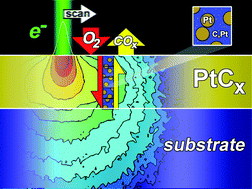Abstract
Electron beam direct-write has recently taken a large step forward with the advent of methods to purify deposits. This development has opened the door for future direct-write device prototyping and editing. In one such approach, an additional beam scanning procedure removes carbonaceous impurities via oxidation from metal–carbon deposits (e.g., PtC5) in the presence of H2O or O2 after deposition. So far, critical aspects of the oxidation reaction remain unclear; experiments reveal clearly that electron stimulated oxidation drives the process yet it is not understood why H2O purifies by a bottom-up mechanism while O2 purifies from the top-down. The simulation results presented here suggest that the chemisorption of dissolved O2 at buried Pt nanoparticle surfaces controls purification in the top-down case while both the high relative solubility coupled with weak physisorption of H2O explains the bottom-up process. Crucial too is the role that the carbonaceous contaminant itself has on the dissolution and diffusion of O2 and H2O. These results pave the way for simulation driven experiments where (1) the transient densification of the deposit can be accounted for in the initial deposit design stage and (2) the deposition and purification steps can be combined.


 Please wait while we load your content...
Please wait while we load your content...